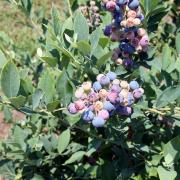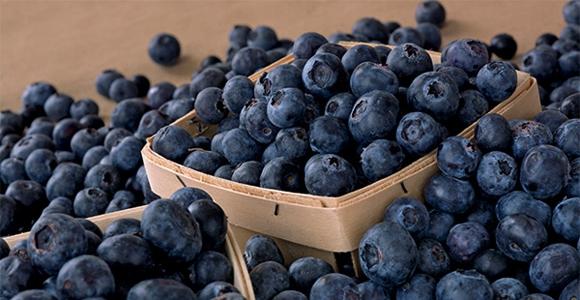

The articles listed below are for commercial blueberry growers interested in
organic production.
Blueberry Freeze Damage and Protection Measures
Blueberry General Production Articles
Organic blueberry prices have historically exceeded conventional prices received by 20 to 100 percent, and in general are subject to reduced price variability across the marketing season. The authors present enterprise budgets, economic cost and returns, and sensitivity analyses for organic blueberries grown in Oregon following best management guidelines suggested by Extension experts. Individual growers are encouraged to review the publication and adopt the information to include their own best estimates of relevant production, harvest and market scenarios.
Planning Budgets for Blueberry Production
This report is designed to provide planning data to farmers, research and extension staffs, lending agencies, and other people in agriculture.
Blueberries may be marketed at roadside stands, at pick-your-own operations, at on-farm sales or at farmer’s markets. There also are well-established wholesale markets for both fresh and frozen blueberries.
Organic Matter Additions for Blueberries
Blueberries require soil with a pH of 4.5 to 5.5. For soils that typically have a low organic matter content, incorporating peat moss or well-decayed pine sawdust or bark will improve plant survival and growth.
Blueberries require a lower pH than many other fruit and vegetable crops. Before planting blueberries, test the soil to determine the pH level, as well as amounts of nitrogen, phosphorus, potassium and organic matter present.
Blueberry Freeze Damage and Protection Measures
Blueberry Freeze Damage and Protection Measures
Commercial blueberries are generally planted in low areas with high organic-matter content. These sites satisfy the cultural requirements of blueberries for a constant and uniform moisture supply. However, on cold, still nights when radiation frosts occur, heavy cold air from higher surrounding areas “drains” into the low areas causing lower temperatures.
Frost and Freeze Protection for Blueberries
Most rabbiteye blueberry varieties require 400 chill hours to 600 chill hours (hours below 45 F) to break dormancy. Until the cold requirement is achieved, an extended period of warm weather usually will not cause floral budbreak.
Postharvest Cooling and Handling of Blueberries
Blueberries are a popular early summer small fruit. Successful blueberry marketing requires that the fruit not only be of very high quality but that it also be properly packaged and thoroughly cooled.
Bees, Blueberries and Pollination (Video)
Bob Danka for the USDA/ARS explains the importance of bees for blueberry pollination. Click on the image to start the video.
Instructions for Taking a Soil Test
Certain steps need to be taken to get a proper soil test. Learn what needs to done to ensure you get a soil test that will benefit you by reading this article.
Knowing the type and amount of nutrients in your soil, could save you, as a blueberry producer, money. To do this, it is important to have your soil tested.
Having soil tests performed by professionals in legitimate laboratories is important for blueberry producers, as producers of other crops.
Recommended for southern areas of Mississippi.
Blueberry Varieties: Rabbiteye
There are many varieties of rabbiteye blueberries. Planting two or more varieties for cross-pollination ensures fruit set and earlier ripening
Blueberry Varieties: Southern Highbush
A new category of blueberries, Southern Highbush, has been developed for southern production. These varieties combine the late blooming date and shorter ripening period of the northern highbush and the low chill hours and adaptability to the southern environment of the rabbiteye.
The flesh of the ripe fruit is so firm it has been described as crunchy
Medium-sized fruit with: good color, flavor, firmness, and small picking scar.
Mid- to Late-Season Blueberry Varieties
Mid- to late-season blueberry varieties include Tifblue, Powderblue, Centurion and Baldwin.
Blooms and ripens about the same time as Biloxi.
Bloom often begins in the fall and continues during warm periods until normal bloom time.
Recommended for planting in the upper part of the South because it requires a period of 800 to 1,000 chill hours.
Fruit is firm, medium-sized, good flavor, small scar, and somewhat darker than other cultivars
Flowers later than rabbiteye and ripens late April in south Mississippi.
Ripens late April to early May.
Ripens late April to early May in Mississippi.
Excellent performance in postharvest studies.
Blueberry General Production Articles
Bare Root Blueberry Plants v. Container Blueberry Plants (Video)
In this video, David Himelrick of the LSU AgCenter explains the difference in obtaining and planting bare root blueberry plants and containerized blueberry plants.
The potential benefits of using biotechnology to improve the production system are great, and public interest and investment in the field are growing.
Blueberry Phenology: Vegetative Growth
In blueberry plants, root and shoot growth occur in flushes throughout the growing season.
Blueberry Insect Pest Identification Guide
The intent of this guide is to inform blueberry producers of all blueberry pests that can attack blueberry crops in the United States.
How Many Blueberry Plants are Needed (Video)
Now that you’ve decided which blueberry varieties you want to plant, how many blueberry bushes should you order? David Himelrick of the LSU AgCenter says it’s a question of how much you like blueberries. Watch this video and find out how to determine how many blueberry bushes you should order.
Mulching with organic materials, such as pine bark, pine needles, leaves, hay, wood chips, sawdust or other organic materials is very beneficial for soil health. Well-maintained mulch can help control weeds, and keep soil cool, loose and uniformly moist.
Plant More Than One Blueberry Variety (Video)
Which blueberry variety you should plant is the first thing to consider when planning to plant blueberry bushes. In this video, David Himelrick of the LSU AgCenter says it’s important to plant more than one variety to ensure cross pollination.
Plant the Proper Blueberry Variety (Video)
The type of blueberry bush you plant depends on where you live. David Himelrick from the LSU AgCenter discusses the four types of blueberry bushes: Wild or Lowbush Blueberries, Highbush Blueberries, Rabbiteye Blueberries and Southern Highbush Blueberries.
Principles of Pruning the Highbush Blueberry
Pruning a plant reduces its ultimate adult size and the crop yield in at least the following season.
After establishment, rabbiteye blueberries require little pruning until they reach about 6 feet to 8 feet in height.
Site Selection for Blueberry Production
Old pasture sites or old farmland with a pH below 5.5 may be well-adapted to blueberry culture.
Soil Drainage and Irrigation for Blueberries
Utilizing proper soil drainage and irrigation techniques are important to growing healthy blueberries.
Experts tell us weed control is one of the greatest challenges when establishing a new blueberry planting.
World’s Blueberries Protected in Unique, Living Collection
Familiar blueberries and their lesser-known wild relatives are safeguarded by U.S. Department of Agriculture (USDA) scientists and curators at America’s official blueberry genebank.
